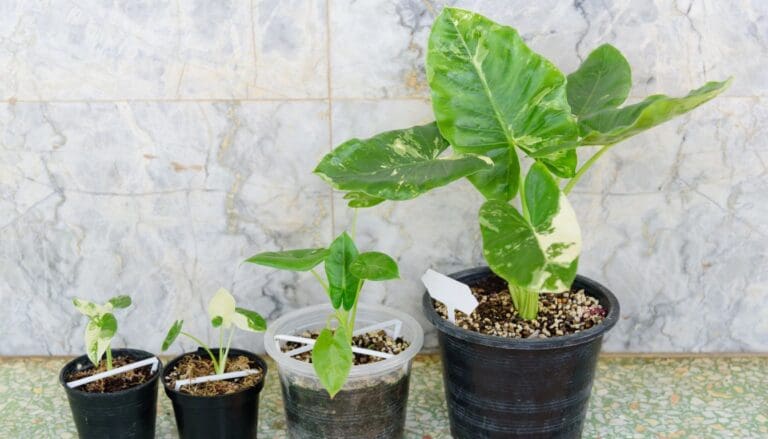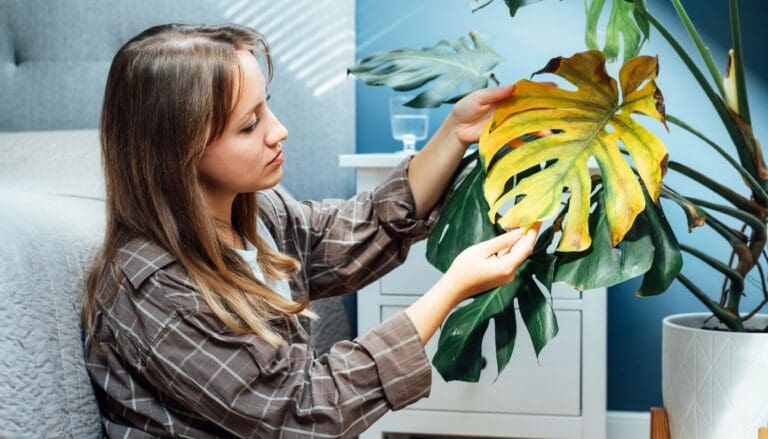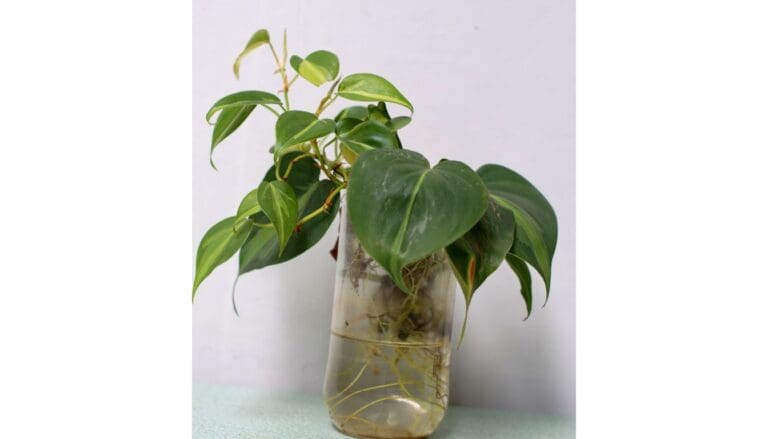Money Tree Leaves Sticky? 2 Causes & Simple Fix!
It is not unusual for the money tree or Pachira Aquatica to become sticky. But you might be wondering why is your money tree sticky and whether it is a good sign or bad. We will take you through all the details and answer all these questions in this article.
Money trees can become sticky due to pest infestation and guttation. When pests invade your money tree, they excrete honeydew which makes your money tree leaves sticky. Another reason could be guttation, where the sap comes out of the undersides of the leaves of the money tree.
It might be daunting for you to identify the reason behind the stickiness of the money tree, but we will discuss some points that will help you distinguish between the two problems and how you can fix them. We will also discuss your next course of action after identifying the problem.

Please note: Simplify Plants is reader-supported. Some links in the post are affiliate links and I get a commission from purchases made through links in the post.
What is sap?
All plants have sap. Money trees have two types of sap – phloem sap and xylem sap.
Phloem sap – Phloem sap is made up of minerals, sugar, and hormones of the plant. This is the sap that pests are attracted to, as this contains more nutrients than the xylem sap. Phloem sap travels from leaves to other parts of the plant, such as roots and stems.
Xylem sap – Xylem sap travels from the roots to all the parts of the plant. It carries nutrients, minerals, and hormones that help in the plant’s growth. The sap that comes out of the money tree leaves during the guttation process is the xylem sap.
Why is my money tree sticky?
If you touch your money tree and your finger feels sticky, you could be wondering what substance is coming out of your plant. As we already discussed, there can be two very different reasons behind it.
It is important to figure out which is the reason for pest infestation and guttation as you would need to act fast if there is a pest infestation, or else your money tree can get into trouble.
Let’s get into the details now.
Pest infestation

Although it is rare for a money tree to get a pest infestation, it can get sticky if overwhelmed by scales or mealybugs.
Pests love to feed on the sap of the plants. So these pests feed on the sap of your money tree and absorb all the nutrition out of it, making it weak and vulnerable.
When these pests excrete, they let out a sugary substance called honeydew, which makes the plant and its leaves sticky.
Now let’s understand the signs that can tell you if your money tree has a pest infestation.
- If you notice round hard bumps on the plant, it means that scales are feeding on your money tree. These bumps are covered by honeydew and might be yellow or brown.
- If you notice cotton-like substances on your money tree, these are mealybugs which are tiny soft pests that make the leaves sticky and yellow.
- If the sticky substance is found everywhere on the leaves and plant, you need not be confused between sap and honeydew. It is honeydew, as it is found in larger quantities on the plant.
How to treat pest infestation?

Removing the pests as soon as possible is the only way of getting rid of the honeydew. Pests can be very harmful as they make the plant weak and susceptible to fungus infections.
There are different ways of eliminating these pesky pests. You can use whichever suits you the best.
First, you need to isolate the plant so that the pests cannot reach and invade the other houseplants.
Next, you need to start the treatment based on which pests have attacked your money tree.
Scales
If your money tree has scale infestation, you will notice tiny bumps that are hard and come in different colors, such as yellow, brown, or black.
You can get rid of the scales by suffocating them. Spray horticultural oil all over the money tree that will not allow the scales to breathe.
If horticultural oil is unavailable, you can create a solution by adding dishwashing soap to water. Dip a cotton ball and apply this to the plant. You can take a cloth, dip it in this solution, and wipe the plant’s leaves to get rid of the pests.
You can also apply rubbing alcohol to wipe away the scales carefully from the plant.
Continue this process for a few weeks. If the infestation is more serious, you might need to use a pesticide to get rid of these pests.
Whenever you are wiping the scales off the plant, cover the soil first, as you don’t want the scales to fall into the soil, which can cause an infestation on the plant again.
Mealybugs
To eliminate the mealybugs, you need to give the money tree a good wash first. You must wash the plant thoroughly under running water. Do this twice or thrice to get rid of as many bugs as possible.
Next, use neem oil by spraying it all over the plant and leaves. Don’t miss applying it on the undersides of the leaves.
Continue this process for two weeks at least, and you will be able to get rid of pests like mealybugs or aphids.
Also Read: Does A Money Tree Attract Bugs? (Common Bugs+How To Get Rid Of Them)
Guttation

This process involves sap coming out of the leaves of the plant. This process mainly occurs during nighttime when the humidity is high, and the money tree cannot transpire because of closed stomata.
If the soil of the money tree is moist, the plant will absorb excess water that will travel through the plant and get released from the leaves.
It is not just water that comes out but also the sap of the plant that makes it sticky. You may notice this on the edges and tips of the leaves, along with the undersides.
You will need to clean the leaves but make sure that there are no pests on the plant.
Check the plant thoroughly to ensure there is no pest infestation, and then you can start cleaning the sticky substance.
What to do about guttation?
Guttation is a natural process, and it is not something that you should be worried about.
It is natural for the plant to let out the excess water through this process to relax from the extra moistness due to moist soil, low light, and high humidity.
However, if you overfertilize the money tree, guttation can increase the damage. This is because the minerals from the fertilizer can have a build-up on the tips of the leaves, causing leaf burn. White spots on the leaves might follow this, which is the accumulation of the minerals.
You will need to reduce the dosage or the frequency of fertilizing the money tree. You can also wash the soil thoroughly to remove the excess fertilizer from the soil.
Guttation is often mistaken as a sign of overwatering, but it is not so. It is a natural process. However, if you notice yellow or wilted leaves on the plant, you might need to inspect the roots and check if your money tree is overwatered.
One more mistake that people make is that they get confused between guttation and dew drops.
If your money tree is placed outside, you may notice dew drops on the plant. Dewdrops form due to the condensation of moisture in the air.
However, guttation is an entirely different process where the moisture comes out of the plant itself.
How to keep a money tree healthy?

If you take care of the money tree, you can save it from pests and other problems. Consider following the below-mentioned tips that can help you take better care of your money tree.
- Keep your money tree in a bright environment. Pests thrive in a low-light area that is not an ideal condition for the money tree. So, you should provide sufficient indirect light to your money tree to keep pests and other problems away.
- Avoid overwatering the money tree. If the soil remains moist and wet most of the time due to overwatering, it will damage the roots, cause root rot, and invite pests. Both root rot and a pest infestation can be deadly for the plant. Water your money tree only when the soil is 50-75% dry.
- Fertilize the money tree with a light dose during the growing season. If you fertilize your money tree with a heavy dose, it will burn the roots and will flow from the roots to the leaves through the process of guttation and have a build-up on the tip of the leaves.
- Spray neem oil solution on your money tree once a month, even if there is no pest infestation, as this also acts as a preventive measure.
- Keep the money tree in a pot with drainage holes that let excess water out of the pot. Use peat-based or cactus blend soil that supports well drainage and does not hold excess water that can lead to excess moisture retention.
Reference: WIKIPEDIA.
Recommended Garden Supplies
| Product Image | Our Recommended Gardening Supplies | Check Offers! |
|---|---|---|
Top Top
Top
Top
Top
Top
Top
Top
Top | rePotme Houseplant and Tropical Classic Potting Soil Mix | Check Offer On Amazon |
 Top
Top
Top
Top
Top
Top
Top
Top | Espoma Organic Indoor Plant Food | Check Offer On Amazon |
 Top
Top
Top
Top
Top
Top
Top
Top | GooingTop LED Grow Light 6000K Full Spectrum Clip Plant Growing Lamp | Check Offer On Amazon |
 Top
Top
Top
Top
Top
Top
Top
Top | Soil Moisture Meter | Check Offer On Amazon |
 Top
Top
Top
Top
Top
Top
Top
Top | Govee Hygrometer Thermometer, Bluetooth Enabled! | Check Offer On Amazon |
 Top
Top | LEVOIT Humidifiers for Large Room(Best For Plants) | Check Offer On Amazon |
 Top
Top
Top
Top
Top
Top
Top
Top | Upgraded DIY Automatic Drip Irrigation Kit, 15 Potted Houseplants Support | Check Offer On Amazon |
 Top
Top
Top
Top
Top
Top
Top
Top | Stainless Steel Heavy Duty Gardening Tool Set | Check Offer On Amazon |
 Top
Top
Top
Top
Top
Top
Top
Top | Bonide Insecticidal Soap | Check Offer On Amazon |
 Top
Top
Top
Top
Top
Top
Top
Top | Bonide 32 oz Spray Neem Oil for Organic Gardening | Check Offer On Amazon |
 Top
Top
Top
Top
Top
Top
Top
Top | Garden Safe Fungicide | Check Offer On Amazon |







I don’t see any bugs at all on my money tree. There is alot of sap. Sometimes the leaves turn brown and yellow. I don’t know what is wrong. Most of I would hate to lose it because my grandson gave it to me.
It sounds like you really care about your money tree! Sap on the leaves can sometimes be a sign of stress, overwatering, or root issues, even if you don’t see bugs. Make sure the pot has good drainage and let the top inch of soil dry before watering again. Brown and yellow leaves are often caused by too much water or not enough light. Try to keep it in bright, indirect light and avoid letting it sit in water. With a few adjustments, your money tree should bounce back!